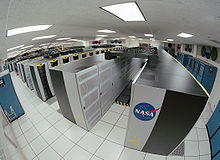User:Millosh/Internet and Programming for Linguists/The Big Picture/Computer
A computer[1] is a machine for manipulating data according to a list of instructions.

Computers take numerous physical forms. Early electronic computers were the size of a large room, consuming as much power as several hundred modern personal computers. [2] Today, computers can be made small enough to fit into a wrist watch and be powered from a watch battery.
Society has come to recognize personal computers and their portable equivalent, the laptop computer, as icons of the information age; they are what most people think of as "a computer". However, the most common form of computer in use today is by far the embedded computer. Embedded computers are small, simple devices that are often used to control other devices—for example, they may be found in machines ranging from fighter aircraft to industrial robots, digital cameras, and even children's toys.
The ability to store and execute programs makes computers extremely versatile and distinguishes them from calculators. The Church–Turing thesis is a mathematical statement of this versatility: Any computer with a certain minimum capability is, in principle, capable of performing the same tasks that any other computer can perform. Therefore, computers with capability and complexity ranging from that of a personal digital assistant to a supercomputer are all able to perform the same computational tasks as long as time and storage capacity are not considerations.
See also
edit| Wikiquote has a collection of quotations related to: Computers |
Notes
edit- ↑ This article contains text from English Wikipedia article Computer adopted under the terms of GNU Free Documentation License version 1.2 or any later: Wikipedia contributors, "Computer," Wikipedia, The Free Encyclopedia, http://en.wikipedia.org/w/index.php?title=Computer&oldid=139003746 (accessed June 18, 2007).
- ↑ In 1946, ENIAC consumed an estimated 174 kW. By comparison, a typical personal computer may use around 400 W; over four hundred times less. Template:Ref harvard
References
edit- ^Kempf 1961 a Kempf, Karl (1961). "Historical Monograph: Electronic Computers Within the Ordnance Corps". Aberdeen Proving Ground (United States Army).
{{cite journal}}: Cite journal requires|journal=(help) - ^Phillips 2000 a Phillips, Tony (2000). "The Antikythera Mechanism I". American Mathematical Society. Retrieved 2006-04-05.
- ^Shannon 1940 a Shannon, Claude Elwood (1940). "A symbolic analysis of relay and switching circuits". Massachusetts Institute of Technology.
{{cite journal}}: Cite journal requires|journal=(help) - ^Digital Equipment Corporation 1972 a Digital Equipment Corporation (1972). PDP-11/40 Processor Handbook (PDF). Maynard, MA: Digital Equipment Corporation.
- ^Verma 1988 a Verma, G.; Mielke, N. (1988). "Reliability performance of ETOX based flash memories". IEEE International Reliability Physics Symposium.
{{cite journal}}: Cite journal requires|journal=(help)CS1 maint: multiple names: authors list (link) - ^TOP500 2006 a Meuer, Hans (2006-11-13). "Architectures Share Over Time". TOP500. Retrieved 2006-11-27.
{{cite web}}: Check date values in:|date=(help); Unknown parameter|coauthors=ignored (|author=suggested) (help) - Stokes, Jon (2007). Inside the Machine: An Illustrated Introduction to Microprocessors and Computer Architecture. San Francisco: No Starch Press. ISBN 978-1-59327-104-6.